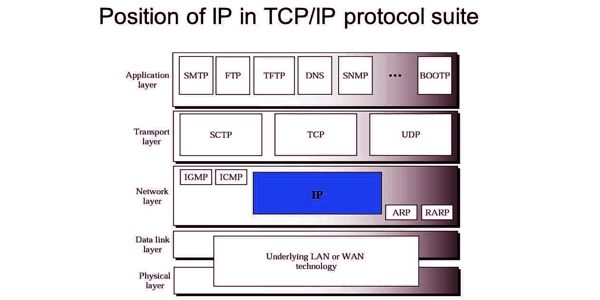The Internet Protocol (IP) is a protocol, or set of rules, for routing and addressing packets of data so that they can travel across networks and arrive at the correct destination. It is the principal communications protocol in the Internet protocol suite for relaying datagrams across network boundaries. Data traversing the Internet is divided into smaller pieces, called packets. IP information is attached to each packet, and this information helps routers to send packets to the right place.
IP has the task of delivering packets from the source host to the destination host solely based on the IP addresses in the packet headers. Every device or domain that connects to the Internet is assigned an IP address, and as packets are directed to the IP address attached to them, data arrives where it is needed. For this purpose, IP defines packet structures that encapsulate the data to be delivered. In networking, a protocol is a standardized way of doing certain actions and formatting data so that two or more devices are able to communicate with and understand each other.
The Internet Protocol (IP) is a set of requirements for addressing and routing data on the Internet. IP can be used with several transport protocols, including TCP and UDP.
An IP address is a unique identifier assigned to a device or domain that connects to the Internet. Each IP address is a series of characters, such as ‘192.168.1.1’. Historically, IP was the connectionless datagram service in the original Transmission Control Program introduced by Vint Cerf and Bob Kahn in 1974, which was complemented by a connection-oriented service that became the basis for the Transmission Control Protocol (TCP).
The first major version of IP, Internet Protocol Version 4 (IPv4), is the dominant protocol of the Internet. Its successor is Internet Protocol Version 6 (IPv6), which has been in increasing deployment on the public Internet since c. 2006.

Function
The Internet is made up of interconnected large networks that are each responsible for certain blocks of IP addresses; these large networks are known as autonomous systems (AS). The Internet Protocol is responsible for addressing host interfaces, encapsulating data into datagrams (including fragmentation and reassembly) and routing datagrams from a source host interface to a destination host interface across one or more IP networks. A variety of routing protocols, including BGP, help route packets across ASes based on their destination IP addresses. For these purposes, the Internet Protocol defines the format of packets and provides an addressing system.
Each datagram has two components: a header and a payload. The IP header includes source IP address, destination IP address, and other metadata needed to route and deliver the datagram. The payload is the data that is transported. This method of nesting the data payload in a packet with a header is called encapsulation. Each IP packet will contain both the IP address of the device or domain sending the packet and the IP address of the intended recipient, much like how both the destination address and the return address are included on a piece of mail.
IP addressing entails the assignment of IP addresses and associated parameters to host interfaces. IP is primarily responsible for providing legitimate network addresses and the encapsulation and routing of data packets across one or many IP-based networks. The address space is divided into subnetworks, involving the designation of network prefixes.
Information Source:
















